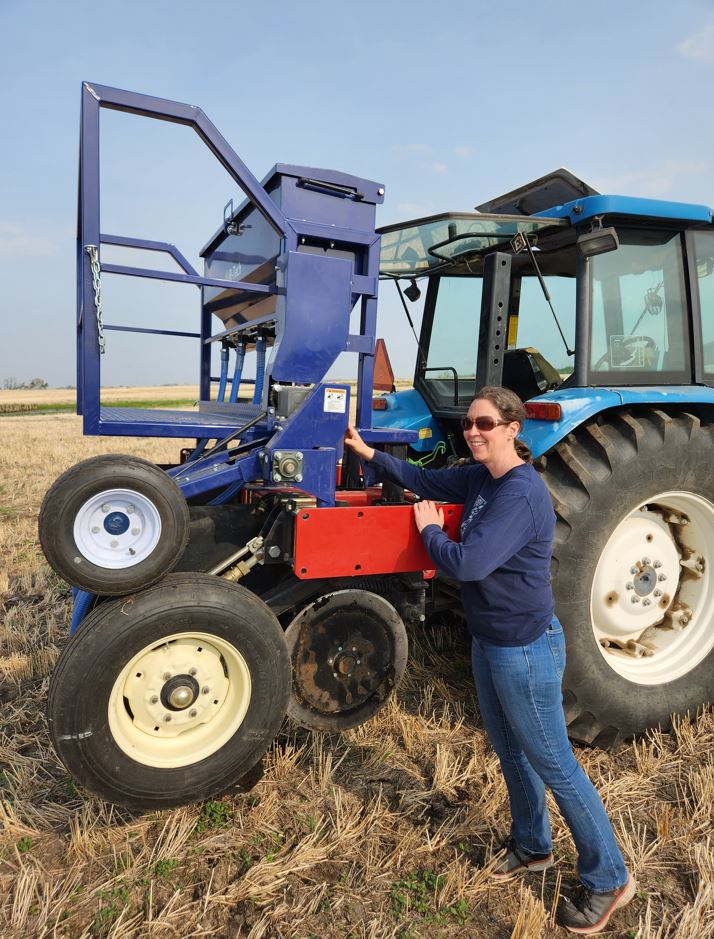WGRF Research Chair Ensuring Sustainability is Profitable
How to create more resilient cropping systems
When covid threw Dr. Maryse Bourgault a curveball, she found a new approach that reflects how she’s tackling her new role as WGRF Research Chair in Integrated Agronomy at the University of Saskatchewan. “When I was hired in March 2020, I was fresh into the department and had a big puzzle to figure out with this new research position,” says Bourgault.

She’d planned to start the seven-year position with farmers – talking about what integrated agronomy means to them. It was input she’d use to look at sustainability from a larger perspective, including the environmental, financial and social dimensions. But when travel and research work wasn’t initially possible, Bourgault looked for other ways to start her work.
“Integrated agronomy is an interesting term,” she says. “Sometimes it’s easier to talk about systems because I want to look at approaches for integrating different crops that will improve resilience, sustainability and profitability for grain production in Western Canada.”
Winter cropping
Late in the summer of 2020, Bourgault was able to get started planting winter crops, the first of several field research projects. “We’ve had some success with winter camelina,” she says. “We’re planting it in the fall at four different seeding dates to try and figure out the best planting time. And we’re also increasing plant density to see if this helps plants withstand some winter kill and still have a good stand in the spring.”
The winter cropping program has expanded to include the testing of several varieties of winter peas and lentils. “We keep repeating the trials, trying different things to uncover what might work best,” she says. “Winter camelina is looking interesting in a rotation with winter cereals.”
Bourgault also wants to reintegrate livestock into cropping systems. She’s incorporating annual and perennial forages to determine how intensely livestock can be part of this system. Cows are grazing on forages and are free to move around, while the grain plots are fenced off. She also wants to determine how much of a contribution livestock make to soil health by being part of this system versus just having a perennial plant system.

“This crop livestock reintegration study has been an interest of mine and percolating for a few years, so the extra time from the pandemic gave me more time to focus and frame the project,” says Bourgault.
Intercropping options
There’s growing demand for faba beans, a legume that fixes more nitrogen than any other. And when Bourgault looked at intercropping them with cereals, it became clearer what doesn’t work.
Finding a fit for faba beans in an intercropping system hasn’t panned out. “We found that oats are very competitive with water and the beans couldn’t compete, even in years with normal precipitation levels. But faba beans and flax might work.”
This study also investigated intercropping peas and canola, which is very productive. They found it was possible to use less nitrogen fertilizer and increase yields in both crops, compared to growing them separately.
Cover cropping
Working with researchers at the University of Manitoba and University of Alberta, Bourgault is getting insightful information from studying cover crops – an approach designed to provide erosion control and generally improve soil health. “People are often concerned that cover crops will use too much water at the expense of the cash crop,” she says. “We aren’t actually seeing competition from the cover crop, but we are finding that cover crops are having trouble getting established.”

Part of the problem, Bourgault expects, is herbicide options. “We are looking at herbicides you could use without having too much impact on the cover crop, but that will also control weeds in the cash crop,” she says.
She’s also looking into perennial versus annual species options as cover crops that might need a year to get established before the benefits are seen, as well as getting cover crops growing in the fall in regions where there might be enough hospitable late season weather.
The on-farm factor
With just a few years of results in hand, Bourgault isn’t giving on-farm recommendations about integrated agronomy. “I’m still at the point where I want to hear feedback from farmers about the approaches we’re working on. I’m not the type of person to tell people what to do. I’d rather share our experiences and let farmers see what might fit, or not, on their farm.”
While all the current research projects are taking place on university plots, Bourgault would like to form more relationships with farmers who might be interested in on-farm trials. She’s joined the board of SaskSoil as one way to connect with people that share her passion for soil health and interest in trying things differently with crop production.
As her research continues, Bourgault plans to keep looking for opportunities to tap into grassroots ideas to fuel her research across commodities to gain a bigger picture view on sustainability and profitability.
